
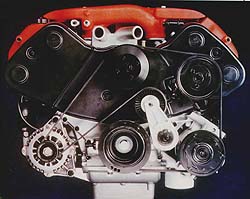
V8 Engine Liner Problems
A brief explanation to the problems suffered by V8 owners
Anyone whose done a little research into buying a V8 will know about a problem with the early engines that requires a lot of expensive work. Originally if was felt the buying a post '98 V8 was a way of missing this possibly expensive problem, unless the Esprit had had the work done already.
After some research into the problem, by LEW and some V8 owners, the fault has been found to be the sealer for the engine liners. Also it has been found that the problem wasn't rectified at the factory until around June 2000. So it is possible for any pre June 2000 Esprit will have this fault arise.
What happens is the sealer used to seal the liners in each cylinder, to stop water that cools the engine mixing with oil that lubricates the engine, can fail if the engine overheats. This results in water leaking into the cylinders and ending up in the sump.
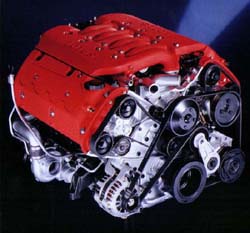
Engine water leaks :-
Some early cars experienced cooling problems for various reasons ranging from
poorly sealing pressure caps (water not returning to the main header tank)
resulting in engines overheating to simple leaks from hose connections.
We recommend that any car experiencing water loss have the cooling system checked - by breaking into the overspill pipe and pressure testing the system to ensure no leaks and that the pressure cap is holding the correct pressure before 'blowing off'.
You would be surprised how many older cars have defective caps - i.e. blowing off at a much lower pressure than specified. Many people check the system through the cap connection with a standard service tool - this checks the system but does not ensure the cap is working properly on the header tank !
Something as simple as this is commonly to blame for many water loss issues. It was found that once an engine overheated the result was that the liner sealant seemed to break down and cause a leak round the base of the liner. This was investigated and a new sealer was specified for new build and engine repair (sealer changed from Loctite 572 to Hylomar 3400 on a Dealer Service Bulletin in June 2000 following extensive durability testing) We have also seen the odd thing like the water pump impellor coming loose (resulting in no water flow and overheating), corroded blanking plugs in the cylinder heads of some early engines (plug insertion depth now changed to eliminate problem), the odd poor casting which can cause a leak etc.
The cooling system of the Esprit has undergone a few changes in configuration. First please check the following:


Maintenance Procedure
1. With the engine completely cold, adjust the coolant level in the header
tank at the right hand rear of the engine bay, to the bottom of the filler
neck. The expansion tank in the right hand rear wheelarch may be empty, as
any contents will be expelled when the engine is fully warm.
2. Check that the header tank is fitted with a 145 kPa pressure cap, and the expansion tank is fitted with a blanking cap.
3. As the engine warms up, the coolant will expand and start to fill the expansion tank. When fully warm (i.e. the cooling fans have cycled on/off several times), coolant may be expelled from the expansion tank overflow. On cooling down, negative pressure will open a valve in the header tank pressure cap and allow coolant to be drawn back from the expansion tank into the header tank. A small amount of coolant may remain in the expansion tank due to the pressure differential required to open the recovery valve in the pressure cap. The header tank will no longer be full, with the level lying typically at around three quarters full. If the system is not disturbed (i.e. the header tank cap is not removed), further drive cycles should result in the header tank cold coolant level stabilising somewhere between half full and full.
If the header tank is repeatedly topped up to be fully filled (as stipulated in current literature), the subsequent dropping of the level may be perceived as coolant consumption/loss.
Another point to check is the hose between the header tank and expansion tank which can leak air and prevent the coolant from the expansion tank being recovered. Rubber hose tends to be more durable than the clear plastic hose originally fitted.
There was a running change of the cylinder liner sealant in June 2000 to Hylomar 3400, which allows the heads to be removed without the necessity to re-seal the liners. A significant leak at this joint will result in water contamination of the oil, although small leakages will evaporate off. Diagnosis requires removal of the sump for inspection whilst the cooling system is pressurised.
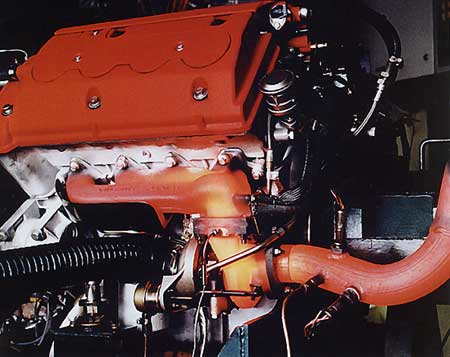
Owners Views and Experiences
If you have one or more liners leaking water into the oil sump. You can check this by looking at your engine oil. You will actually see the oil (creamy stuff) in the water and you will see it even more when you drain the oil (water comes out first). I did two attempts last year to two Esprits that had the same problem and after the treatment the problem never came back !
Here is what I did:
- changed oil
- drained the cooolant (only on one car that alredy had put
Radweld in it)
I personally feel that Radweld is NOT the correct stuff for this problem,
because the liners get too hot for Radwelt to hold up for longer time.
- I put BarsLeak into the whole cooling system.
This stuff is really great. Its way different to Radweld. It comes in a
black tin and loocks like medicine pills ;o)
On both cars the problem completetly disappeared ! I got this tip from a Jaguar mechanic, because they have to use BarsLeak at every service for the older 6-Cylinder engines. Even Jaguar advises to put it into the coolant ! You have nothing to loose. Try it.
Cheers
Marcus (PUK Esprit Racing)
I agree there can be many reasons why v8 owners experience coolant loss. Fact remains that in MY case, the problem was diagnosed (with the sump off for visibility) by the lotus factory field engineer as the "porous" / leaking liner problem.
A new pressure cap was the first thing that had been tried, followed by checking all the hoses/clamps, re-fill/ bleeding the system, checking the rad, thermostat, pump etc.. I did not experience any overheating prior to coolant loss BTW.
Radweld or similar would possibly not have been a good idea in my case, as the leaking water had done some damage internally which necessitated a new piston and liner in no8 cylinder, plus a couple valves.
cheers
Rob Ellis 99 V8-GT
I haven't posted for a while but can comment on the V8 problem from experienceI had a 1998 V8 GT (same spec as Rob Ellis'). It suffered coolant loss at 14000 with Lotus supplying a new engine at 16,000. I then bought my current sport 350 (No.007). It suffered exactly the same symptons at the same mileage and lotus also replaced that engine. I have since done 19,000 miles in that engine (touch wood...). Cars never suffered from overheating - just gradual coolant loss.
Cheers
Ken Baird 99 Sport 350
I can confirm on my 02 V8 that the liners were the cause of coolant loss - at the worst point, I was topping up with about 2 litres a week and that was on quite low weekly mileage. The symptons first appeared when I had covered about 24K miles. Incidentally, there was no sign of overheating - just the tell light indicating low coolant. The work was originally scheduled to be carried out at the dealers – although after it had been inspected by Lotus, they insisted on doing the work at Hethel because the problems was 'very serious' In the end, they replaced all the liners to be on the safe side and the whole process took about 6 weeks.
All the best
John Roberts 2002 V8
![]() From Lotus on possible 2002 Liner Problems (John
Roberts 2002 V8)
From Lotus on possible 2002 Liner Problems (John
Roberts 2002 V8)
I have been looking into the documentation on car with the Liner Seal Problem.
This was the car identified (by JCT) as having a water leak from the liners
into the crankcase.
Vehicle - SCCDA08202HC*****
The vehicle was shipped back to Lotus for repair in October 2003 During the repair no component mechanical fault was found (block or liners). It can therefore be assumed that the problem was associated with the liner sealing compound or the application during the production build of the engine.
The Engine was rebuilt at the Lotus Service Centre by our factory trained Technician. The liner sealer used was the correct specification Hylomar 3400 (changed from Loctite 572 to Hylomar 3400 in early 2000) The leak could have been caused by either poor / incomplete application of the sealer or the cylinder head not clamped down within the prescribed time (4 hours).
The Engine build procedure details the application and assembly details which should have been followed by our Engine Builder at that time. Both of the above could cause a premature failure of the 'Liner Seal' and let coolant sep into the crankcase. To date this is the only recorded malfunction of the new Hylomar 4300 sealer in the 600 engines built since the introduction of the this specification liner sealing.
I believe the car is now in good health and should not have any further problems. I believe all cars built after the introduction of the liner sealer Hylomar 3400 should be trouble free.
The engine in question was built during the period the Engine was assembled by a third party (the engine was assembled off - site for a time due to space restrictions) The engine assembly company were fully trained and have a good reputation in the Automotive business but the odd error can creep in.
All future engine build will be carried at Lotus so we should not have any repeat problems. Our Service Centre Technician (for V8 engine work) is fully aware of the importance of the liner sealing procedure and he was the technician that rebuilt the engine. Hopefully all will be o.k. in the future.
The Liner Sealer update was introduced on Service Bulletin 2000/3 in June 2000.
The Production Build changed early in 2000 at Engine No. 30600
![]() Lotus
Update
Lotus
Update
As regards the liner sealant, I fear the source of this popular
misconception may be an internet gossip/chat room, the like of which can
be
valuable and entertaining, but also a source of self perpetuating myth. In
June 2000, the sealant between the cylinder liners and the block was
changed
from Loctite 572 to Hylomar 3400 as a specification update.
This running change is but one example of Lotus' policy of continuous product improvement, with myriad others occurring over the life of the V8 Esprit between '96 and '04. As new products come onto the market, and better ways of doing things are found, these are incorporated into the cars in cost effective ways to the benefit of Lotus and its customers alike.
The
original type of sealant is perfectly satisfactory providing the engine
is
not allowed to overheat, in which case the 918 engine is no different
to
any
other in potentially experiencing a range of problems.
Dave Massey - Technical Service
Senior Technical Author
Lotus Cars Ltd.,
![]() Lotus
Open up their V8
Lotus
Open up their V8
Lotus
confirms that Hylomar 3400 (A918E0377V) is the correct product for the Lotus
Esprit V8 Liner / Block sealing.
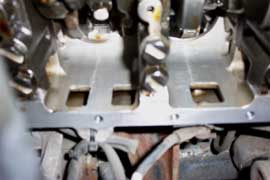
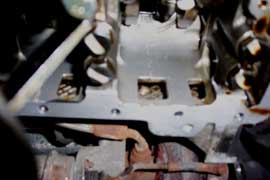
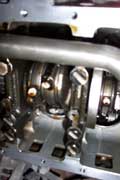
Following the ongoing discussions on the Lotus V8 Liner sealing issue Lotus have inspected their V8 engine in there Engineering vehicle for any signs of coolant loss into the crankcase. (carried out Wednesday 8th June 2005). The engine was a production built unit using Hylomar 3400. The liner assembly procedure was as per the build instructions detailed in section ED of the Lotus Esprit Service Notes and Service Bulletin 2000/12 (June 2000).
The results were as follows :-
Following removal of the oil pan no sign of coolant leaks (staining in the
crankcase) was found. See pictures above right.
The cooling system was pressurised to 2 bar (for 30 minutes) - no sign of
water leaks round the liner sealing was evident.
The life of this vehicle is continually monitored and every mile can be accounted for. The vehicle has no record of any cooling system malfunction (water loss or overheating) which could have an influence on the integrity of the operation or durability of the engine.
The vehicle is serviced to the current Esprit V8 Service
Schedule. From our experience any engine problems related to water loss both
internal & external (head gasket failure, liner sealing problems etc.)
is
usually associated with an earlier cooling system problem such as low
water level, air locks, inefficient (blocked) radiator or defective
thermostat.
Lotus also always ensure any adhesive used in the build / overhaul of engines is from a source that ensures it was stored as per the manufacturers recommendations and within the recommended shelf life.
More info from Lotus
14th June 2005
The reason for posting the Liner pictures was to confirm that the liner seal
(Hylomar 3400) does not just disappear (and cause coolant to leak into the
crankcase) in a Glycol environment as claimed. This check can be used by
owners to identify if there is a liner sealing problem without removing and
stripping the engine. The pressure test can also be carried out at this time
and any leaks will be visible. Access to the crankcase can be gained by
removing the Oil Pan (the procedure carried out in this case)
This information is to help owners confirm whether or not they have a liner
sealing problem with the minimum of engine disturbance.
When there is a leak there is evidence of antifreeze staining on the crankcase sides. (ensure not to confuse any oil staining on the crankcase casting with genuine Antifreeze stains - easily done) This particular car has done in excess of 20,000 miles development work. We have records from other cars that have completed well in excess of 50,000 miles on both Loctite and Hylomar liner sealants We also have Engine Dyno. test results from Engine durability programmes that confirm sealant integrity.
From our experience liner sealant failure usually follows some form of Engine overheating / malfunction due to some other component problem (for example water pump, thermostat, radiator, pressure cap) or Engine overloading / modification.
It must be noted that all the Lotus testing (Dyno. & Vehicle) was done with the production Power & Torque levels. This creates known engine performance and hence running conditions (airflow, temperature, vibration etc.).
Lotus cannot guarantee the integrity of the engine / components when any modifications that increase or change performance are installed on the vehicle. The Engine is certified, tested and validated at 350 BHP and 400Nm Torque.
The Maintenance Procedure detailed in the Liner Section on LEW is vital to the sound operation of the vehicle / engine.
Hopefully the above information will be helpful to owners.
Lotus Cars
Engine numbers
by Chelsea Martyn
Straight from the horses mouth at Hethel, so this eliminates any confusion.
I'll use my engine number to demonstrate
LL918990930122
LL918 = Engine type number in this case the 3.5ltr V8
99 = Year Buill 1999
09 =Month Build September
30122 = Lotus serial number that is a continuation of all engines ever built.
30123 may be on another V8, but could have been assigned to an Elise / 4 pot engine. So the important bit of year and month is accurate and essential to anyone avoiding a Loctite sealed engine from new, unless it has been carried out in aftersales for example.
![]()
If you wish to add your views or experiences to this page, email admin@lotusespritworld.com
|
|